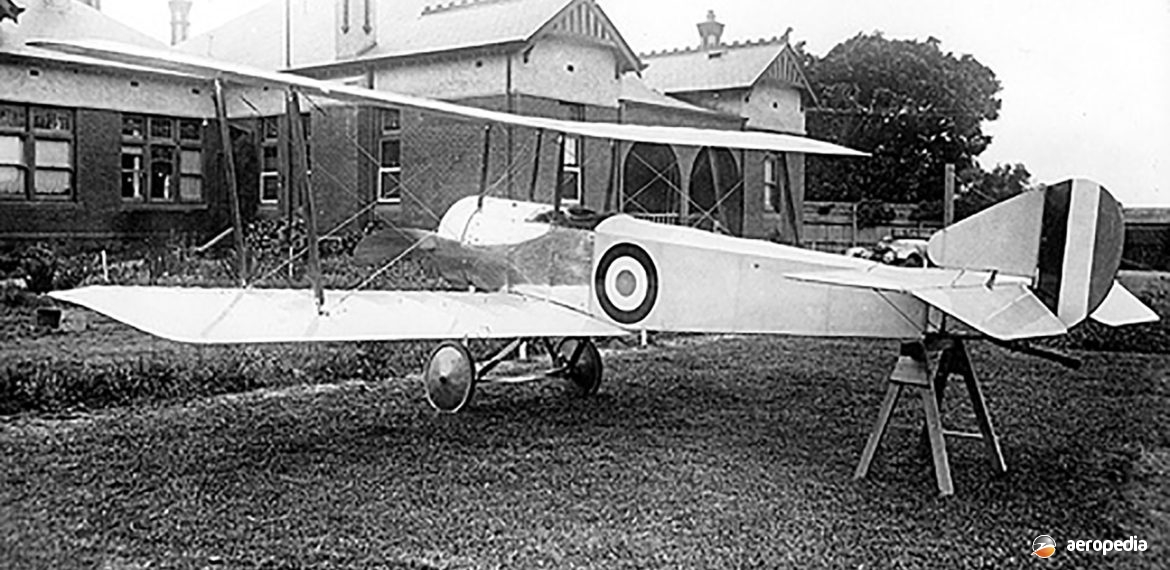Photograph:
The Watson Biplane in about 1919 (Frank Walters collection)
Country of origin:
Australia
Description:
Single-seat light biplane
Power Plant:
One 37 kw (50 hp) Gnome seven-cylinder rotary piston engine
Specifications:
- Wingspan: 1.82 m (6 ft)
- Length: 5.48 m (18 ft)
- Wing area: 21.36 m² (230 sq ft)
- Cruising speed: 129 km/h (80 mph)
History:
Basil George Watson was born in Bendigo, VIC on 12 October 1894 and was the son of a mining investor. He was one of Australia’s early aviators who flew with the Royal Flying Corps in 1916, having learned to fly in 1915 on a Hall Biplane at Hendon, in Greater London, UK and was awarded Brevet No 1910 by the Royal Aero Club of the United Kingdom on 18 October 1915. He flew for Sopwith Aircraft in the United Kingdom as a test pilot. On one occasion he flew from Brooklands in Surrey on 22 June 1915 in an aircraft fitted with a 112 kw (150 hp) Sunbeam eight-cylinder engine but the engine seized and he crashed into a tree and suffered some injuries. He returned to Australia on board the TS Athenic in April 1916 and purchased a Gnome rotary engine from H “Horrie” C Miller, this engine coming from a scout biplane owned by Miller.
In about June 1916 he decided to build his own aeroplane. Reports in the United Kingdom claimed the design was from Sopwith but detail differences caused some to accept that it was an original Australian design using information that Watson gained whilst employed by Sopwith. Be that as it may, he certainly had assistance from friends in its construction and it was completed in a period of four months. This was a single-seat biplane built around a Gnome seven-cylinder rotary engine.
One report stated Australian pilot, Harry Hawker designed the aircraft and the design was set out in outline on the wooden floor of a skating rink. This account stated a set of drawings was prepared and brought back to Australia by Watson, together with some metal components. In the United Kingdom noted historians J M Bruce and Philip Jarrett asserted it was known as the Hawker Runabout or Type SLTBP, the first aircraft built in England being completed in 1916 and used by Hawker to visit some of Sopwith’s sub-contractors. They alleged Watson’s aircraft was the second.
Watson’s aircraft was built in the billiard room of his family home in Brighton, VIC and in appearance was similar to a Sopwith Pup but there were some notable differences. Construction was of Tasmanian mountain ash. The engine came from a scout biplane built by H C Miller, as noted above, and it seems also some of the metal fittings and the engine bearers used.It may be some of the metal fittings were left with CLC Motor Garage & Engineering Works by Harry Hawker after he made repairs to the Sopwith Tabloid following a couple of accidents. It is said two machines were ordered from Sopwith and “half a dozen other orders are likely to be placed at an early date”.
The machine was completed by 2 October 1916 and was conveyed to the aerodrome at Point Cook, VIC where approval was granted for trials to be held. The machine was thereafter hangared at Point Cook and on 30 October that year it was noted in the press as “in an aeroplane, which he built himself in Australia, Mr Basil Watson made a ‘nosedive’ of 2000 feet and looped the loop twice at Point Cook”. It was found to be capable of 129 km/h (80 mph) and climbed to a height of 1,524 m (5,000 ft).
An application was made to the Minister for Defence for permission to give a flying demonstration at Bendigo, VIC on 2 December 1916 in aid of the Second Infantry Brigade and many newspaper reports of the time referred to the aircraft giving the demonstration to the crowd at Bendigo, and later flights to Castlemaine and other centres. Watson flew the aircraft from Point Cook to Warrnambool, VIC a distance of 267 km (166 miles) in a time of one hour 55 minutes on 24 January 1917, it being said that this was the longest flight made in Australia at that time.
Watson made many flights in his aircraft. Another flight was from Point Cook to Bendigo in November 1916, returning on 15 December. At various centres he performed aerobatics for the local crowds, these centres including the Warrnambool Racecourse. On subsequent days he flew from Warrnambool to Hamilton in 29 minutes, and flew from Hamilton, VIC to Mount Gambier, SA carrying mail. Mail was also carried from Mount Gambier to Melbourne, VIC.
A Certificate of Registration was issued and forwarded under cover of a letter dated 9 October 1916. In the following months Watson made many well-publicised flights in his aircraft. The last recorded was on 28 March 1917. On this occasion he took off from Albert Park in Melbourne and flew to Point Cook where he performed aerobatics, including a series of loops. However, the wings collapsed and the aircraft fell into the sea approximately 36 metres (40 yards) offshore, Watson being fatally injured in the accident. The engine, propeller and assorted parts of the airframe were recovered and presented to the Industrial & Technological Museum of Victoria in late 1919 and are now held by the RAAF Museum at Point Cook. A section of the fuselage is held by the Museum of Victoria.
On 27 February 1967 Basil Watson’s air-mail flight from Mt Gambier to Melbourne was re-enacted with a Piper Cherokee owned by Aviation Services (Hardingham) Ltd of Parafield, SA the pilot being John Hardingham, accompanied by Douglas Watson, a nephew of Basil. At Essendon, VIC the aircraft was met by Mrs P G Perkin, the sister of the late Basil Watson.

